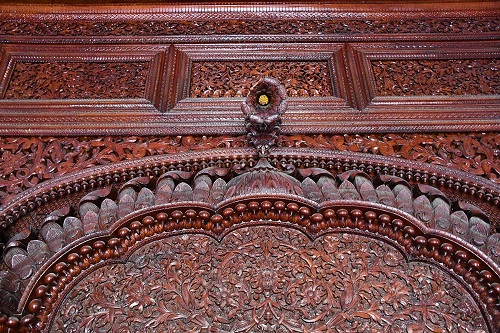
The Jamia mosque of Singwala village, now called Jamia Masjid Farooq-e-Azam, is noted for its impressive paintings and woodwork
Zulfiqar Ali Kalhoro
There are many historical villages in Talagnag tehsil of Chakwal district. One such village is Singwala, which is located about 18 km from Talagang, on the Talagang-Tamman Road. On this road are several villages which host some historical monuments. Amongst these, Singwala village is quite prominent. According to Tariq Mehmood Malik, the historian and writer, the word Singwala is derived from Sing/Seeng (horns). Malik, who is writing a book on the history of villages of Talagang tehsil, notes that two brothers, Saeda (Saeed) and Lisso who belonged to the Rehan lineage of the Awan tribe, from Abaki village, first settled in this village. Dhoke Abaki is located about 10 km from Singwala and lies on the bank of the Soan River. It is the oldest settlement of the Rehan lineage of the Awan tribe who migrated from this village and founded other villages in Talagang and Lawa tehsils. The history and migration of Rehan Awans of Dhoke Abaki to other villages have been discussed in detail in Tarikh-e-Budhial by Muhammad Ghaus.
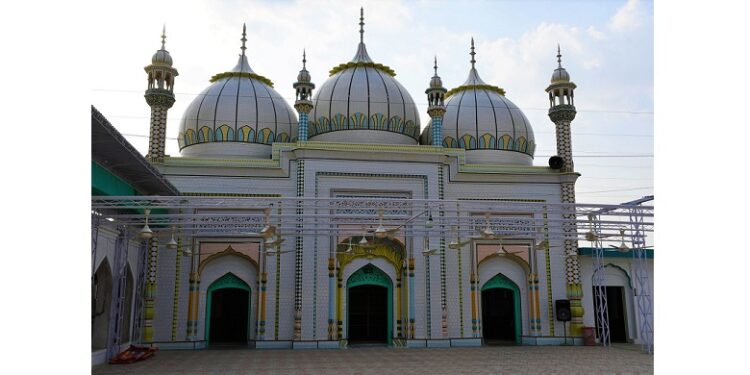
The Singwala village takes its name from the deer horns (Seeng/Sing) that both brothers decorated on the main entrance to their house. People of other settlements recognized the house of both brothers as Singwala, those with horns, and hence due to this appellation, the village came to be called Singwala. Apart from the early history of the village, today it is noted for a grand mosque which is believed to have been built in 1939. During my interviews with the residents of villages, I came to know that the construction work of the mosque started in 1925 and was completed in 1939. It took 14 years to complete the mosque. The same dates are also written on the base of a pillar which was added during a renovation of the mosque in 1993.
There are several historical mosques in Talagang and Lawa tehsils – which are mainly famous for their woodwork, paintings and stone engravings. The majority of these mosques have either been renovated or rebuilt now. The oldest mosque of Talagang tehsil is located in Khichian village and was built during the reign of the Mughal emperor Aurangzeb (r.1658-1707).
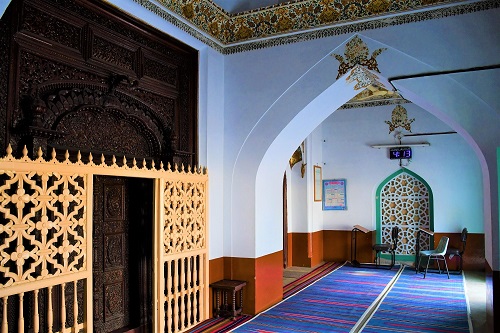
The Jamia mosque of Singwala village, now called Jamia Masjid Farooq-e-Azam, is noted for its impressive paintings and woodwork – a level of craftsmanship which is not seen in any other mosque in Talagang tehsil today. Sirajuddin, the famous mason of Pachnand village in Lawa tehsil, built Singwala Jamia mosque. He was also assisted by his son to dress the stones which were brought from a hill stream. Sirajuddin was a celebrated painter, wood carver, and mason of Pachnand village. He also constructed a mosque in his native village Pachnand which was locally called Tanki Wali Masjid. It was demolished in February 2022 and a new mosque is built which is now called Masjid Khatim-ul-Nabieen (SAW). It was a stone-built mosque which was decorated with paintings. The distinctive feature of the mosque was painted wooden ceilings, doorways, and stone carvings which reflected the dexterity of Sirajuddin Mistri. It is said that the foundation stone of Tanki wali Masjid was laid by Pir Chan Charag of Kalabagh who was originally from Lucknow. He used to visit his disciples in Pachnanad and other villages. His shrine is located in Mochi Mohalla in Pachnand village.
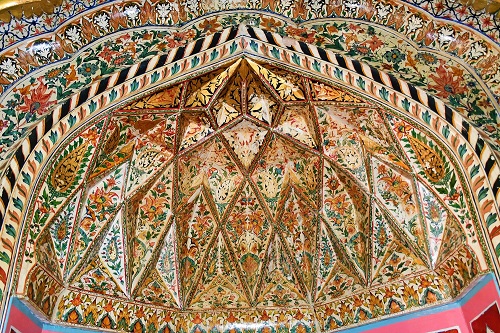
According to Ahwal-e-Talagang by Hamdam Kami (2017), Pir Chan Charag of Kalabagh also used to visit his disciples in Singwala village. They used to ask their followers to build a grand mosque in the village. There was already a small mosque in the village. On the instruction of their spiritual mentor Pir Chan Charag of Kalabagh, the villagers decided to build a grand mosque. It is said that Pir Chan Charag himself supervised the construction of a mosque – for which he sometimes stayed for six months in Singwala village.
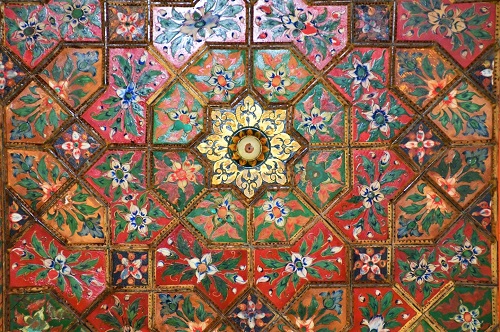
According to Hamdam Kami, one Munshi Ghulam Hussain of Singwala village also played a very important role. He worked in Delhi and took Sirajuddin Mistri to Agra and Delhi to show him Mughal monuments. He wanted Sirajuddin Mistri to build a similar impressive mosque in Singwala village. Whether he visited the Mughal monuments of Delhi and Agra or not, but Sirajuddin’s architectural prowess had no parallel in Talagang tehsil. Both men and women contributed to the construction of the mosque. Women of the village also presented their jewelry so that the construction work of the mosque should not be hampered due to financial issues. The villagers even helped bring stones from a hill stream. The mason Sirajuddin took several years to dress the stone blocks and slabs which were used in the mosque. This is the only surviving stone-built mosque in Singwala and neighboring villages which has paintings.
One enters the mosque through the gateway to the spacious courtyard which has now been rebuilt. The façade of the mosque which depicted stone carvings is now entirely covered with tiles which were added during the renovation in 1993. The famous mason Baba Hayat of Leti village in Lawa tehsil of Chakwal district renovated the mosque. The Singwala Jamia mosque comprises two-aisled prayer halls. The domes are placed on the front aisle instead of the rear hall. The front hall is divided into a bay and two aisles. From the front hall, three doorways lead to the main prayer hall of the mosque.
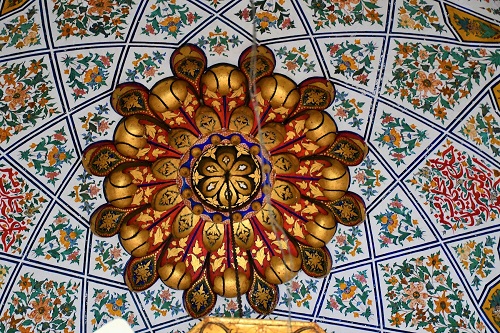
The central doorway is intricately carved and carries a variety of floral designs. One does not find such a highly engraved wooden doors in any other mosque in Talagang tehsil. However, one can see similarly magnificent wooden doors in the Jamia mosque of Ranjha village, Jamia mosque of Chawli village, and Jamia mosque of Fim Kassar villages in Chakwal tehsil. The famous masons and woodcarvers of Chawli Ghulam Ahmed and Ghulam Muhammad, Muhammad Yasin of Ranjha village and Muhammad Khan of Fim Kassar made wooden doors respectively which were used in the mosques. These doors are still extant in respective mosques. Like Sirajuddin of Pachnand, Ghulam Yasin, Ghulam Ahmed, Ghulam Muhammad, and Muhammad Khan were also famous masons and woodcarvers who were known for their skillful craftsmanship.
According to Abdul Rahman Shad (2008), the author of Tarikh-e-Talagang, nails weighing three mounds were used in the central door of the mosque – reflecting how much labor, time and creativity it took, as not a single nail is visible and hidden in the thickness of the wooden door. Every wooden piece on the door reflects his mastery over the art of craftsmanship.
Apart from this central door, there is another carved wooden door that is fixed on the outer eastern wall of the mosque and opens to the front aisle. It is also exquisitely carved and carries a variety of floral and geometric designs.
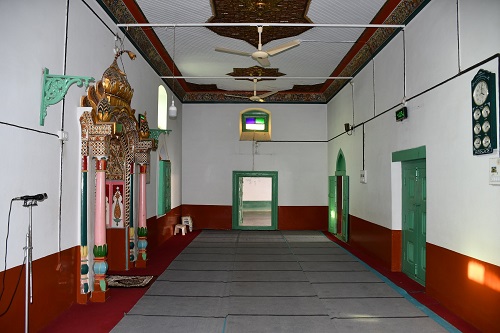
Both halls of the Singwala Jamia mosque, front and rear, are painted. However, many of the paintings are lost now due to renovation in 1993. Only domed ceilings and the zone of the transition retain the painting work. A variety of floral designs are painted on the domed ceilings and the mihrab of the mosque.
The Jamia Mosque Singwala is the most impressive structure in terms of decoration in Talagang tehsil. The decoration was done by Sirajuddin, who died in the 1950s – but still lives on through the creative work that he left behind on the domed ceilings, stone crafted facades and walls of the mosques.
Every motif – be it woodwork, stone craft or painted murals – by Sirajuddin manifests itself like magic in masonry!
_________________
 Dr. Zulfiqar Ali Kalhoro, an anthropologist, has authored 12 books: ‘Symbols in Stone: The Rock Art of Sindh’, ‘Perspectives on the art and architecture of Sindh’, ‘Memorial Stones: Tharparkar’ and ‘Archaeology, Religion and Art in Sindh’. He may be contacted at: zulfi04@hotmail.com
Dr. Zulfiqar Ali Kalhoro, an anthropologist, has authored 12 books: ‘Symbols in Stone: The Rock Art of Sindh’, ‘Perspectives on the art and architecture of Sindh’, ‘Memorial Stones: Tharparkar’ and ‘Archaeology, Religion and Art in Sindh’. He may be contacted at: zulfi04@hotmail.com
Courtesy: The Friday Times Naya Daur Lahore